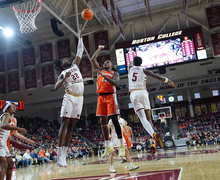SU, ESF rank in financial value
Harvard University, Duke University, Columbia University, and the State University of New York College of Environmental Science and Forestry have something in common.
They all placed in the top 15 of the ‘Best Value Colleges: National Universities’ in the most recent rankings from U.S. News & World Report. Syracuse University ranked 45 on the list.
The analysis, released last month, is intended to help prospective students determine which colleges are more likely to give them financial aid. The rankings are based off the distribution financial aid packages at each university, said Robert Morse, director of data research for U.S. News & World Report.
‘You can see that the cost of ESF after receiving the grant is much less than Syracuse. That’s because of the starting price,’ he said. ‘Syracuse does give out more generous aid packages in case of dollar amount, but the SUNY school gives it to more students.’
The data for the rankings was collected in August 2008 and is based on surveys done by each school’s financial aid office. The list is constructed around three criteria: the ratio of quality to price, the percent of undergraduate students receiving aid and the average discount, Morse said.
The schools are divided into two categories: the percentage of students receiving need-based grants and the average ‘discount’ from the total cost. The total cost is the cost of education, which includes tuition, room, board and meals, minus the average need-based aid grant, Morse said.
U.S. News & World Report determined the rankings by comparing each school’s financial aid packages against measuring the quality of the number one college – this year, Harvard University.
Harvard offers packages to 51 percent of its students. Of these students, each has an average of 68 percent subtracted from their total cost of education, Morse said.
ESF, compared to Harvard, gives 80 percent of its students need-based grants and, with the grants, removes 40 percent of the school’s total cost, according to the report.
SU gives need-based grants to 53 percent of its students that take away an average of 39 percent of the school’s total cost.
The reason for this is mainly the school’s small size in relation to SU, which enables it to give more money to more students, said John View, director of financial aid at ESF.
‘ESF is what I refer to as a niche school,’ View said. ‘We have specialized programs. That is probably our strong point for our size, compared to SU.’
View said student-to-faculty ratio is about 15 to one and that the instructors are full professors.
‘There aren’t that many TAs teaching,’ he said. ‘So it’s a very personal experience.’
His opinion was echoed by some ESF students.
‘ESF is a much better choice financially,’ said Casie Goodwin, a senior paper engineering major. ‘At ESF you get a high quality SUNY education at one of the only schools in the country that is specifically environmentally focused, with all of the benefits of having a large school right next door.’
Published on April 6, 2009 at 12:00 pm





